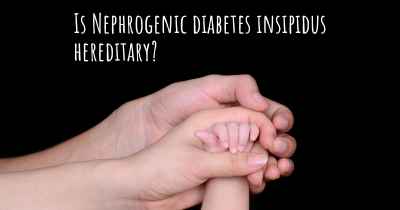What is the history of Nephrogenic diabetes insipidus?
When was Nephrogenic diabetes insipidus discovered? What is the story of this discovery? Was it coincidence or not?

Nephrogenic diabetes insipidus (NDI) is a rare disorder characterized by the inability of the kidneys to properly concentrate urine, leading to excessive thirst and frequent urination. This condition is caused by a defect in the kidneys that prevents them from responding to a hormone called antidiuretic hormone (ADH) or vasopressin. ADH is responsible for regulating the amount of water reabsorbed by the kidneys, thus maintaining the body's water balance.
The history of NDI dates back to the early 20th century when the first cases were described. The term "diabetes insipidus" was coined by the British physician John F. R. Clarke in 1813 to distinguish it from "diabetes mellitus," which is characterized by high blood sugar levels. However, it wasn't until the 1940s that the distinction between central diabetes insipidus (CDI) and nephrogenic diabetes insipidus (NDI) was made.
One of the key milestones in understanding NDI occurred in the 1960s when researchers discovered that the disorder could be inherited. They observed that some families had multiple affected individuals, suggesting a genetic component. This led to the identification of the first genetic mutations associated with NDI in the early 1990s. These mutations were found in the gene encoding the vasopressin V2 receptor, a protein crucial for the kidneys' response to ADH.
Further research in the following decades revealed additional genetic mutations associated with NDI. Mutations in the aquaporin-2 gene (AQP2), which encodes a water channel protein in the kidney tubules, were found to cause a form of NDI known as autosomal recessive NDI. This form of NDI is typically more severe and often presents in infancy or early childhood.
Advancements in molecular biology and genetic testing techniques have allowed for better understanding of the underlying mechanisms of NDI. Scientists have identified various genetic mutations that can disrupt the function of the vasopressin V2 receptor or the aquaporin-2 protein, leading to impaired water reabsorption in the kidneys.
While most cases of NDI are inherited, it can also be acquired as a result of certain medications, chronic kidney disease, or other conditions that damage the kidneys. Medications such as lithium, used to treat bipolar disorder, have been known to cause acquired NDI by interfering with the function of the vasopressin V2 receptor.
Over the years, researchers have made significant progress in developing treatments for NDI. The primary goal of treatment is to manage the symptoms and maintain adequate hydration. This often involves a combination of lifestyle modifications and medication. Thiazide diuretics, which reduce urine production, have been found to be effective in some cases of NDI. Additionally, nonsteroidal anti-inflammatory drugs (NSAIDs) can help improve the kidneys' response to ADH.
Recent advancements in gene therapy and targeted therapies hold promise for the future treatment of NDI. Experimental studies using animal models have shown potential in correcting the genetic defects associated with NDI. However, further research is needed to translate these findings into safe and effective treatments for humans.
In conclusion, Nephrogenic diabetes insipidus is a rare disorder characterized by the kidneys' inability to respond to antidiuretic hormone, leading to excessive thirst and frequent urination. The understanding of NDI has significantly advanced over the years, with the identification of genetic mutations associated with the condition. While treatment options are currently limited, ongoing research offers hope for improved therapies in the future.








